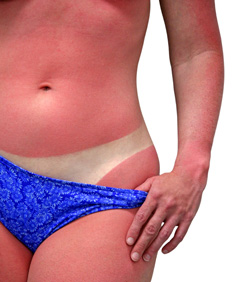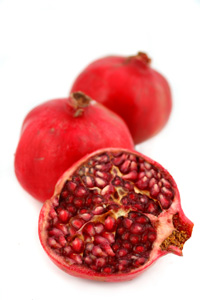 You might want to avoid that poolside margarita this summer. Ditto vodka tonics or other drinks that would have you touching lime peels. The reason? Lime is one of the more problematic sunburn boosters, which can make you more sensitive to the sun’s damaging rays, for a sunburn that would make life very unpleasant.The same goes for celery, by the way, along with many antibiotics, some acne products with benzoyl peroxide and other foods, substances and medications that might be in your bathroom cabinet.This is despite your best efforts to protect your skin with summer skin care habits or using sunscreen. While some folks will have no problems, other people would do well do identify and avoid these potential sunburn boosters – people with fair skin appear to be at higher risk.Signs of sun sensitivity include burning, rashes, bumps and itching or changes in pigmentation after sun exposure. It’s not unlikely you’ve been exposed to a sunburn booster if these changes occur with the same or less sun exposure than you could previously tolerate.
You might want to avoid that poolside margarita this summer. Ditto vodka tonics or other drinks that would have you touching lime peels. The reason? Lime is one of the more problematic sunburn boosters, which can make you more sensitive to the sun’s damaging rays, for a sunburn that would make life very unpleasant.The same goes for celery, by the way, along with many antibiotics, some acne products with benzoyl peroxide and other foods, substances and medications that might be in your bathroom cabinet.This is despite your best efforts to protect your skin with summer skin care habits or using sunscreen. While some folks will have no problems, other people would do well do identify and avoid these potential sunburn boosters – people with fair skin appear to be at higher risk.Signs of sun sensitivity include burning, rashes, bumps and itching or changes in pigmentation after sun exposure. It’s not unlikely you’ve been exposed to a sunburn booster if these changes occur with the same or less sun exposure than you could previously tolerate.
Sunburn Boosters Increase Sun Sensitivity
A sunburn booster is a substance that increases sensitivity to the sun. The latter is called photosensitivity, which increases risk of sunburn. And by now you’re aware of the dangers from that – sun damage is the leading cause of wrinkles and age spots, to say nothing about higher risk of skin cancer.Sun sensitivity is a reaction triggered by the sun’s ultraviolet rays. One example is a phototoxic reaction, which occurs when UV radiation reacts with a drug to form skin-damaging compounds. Symptoms may appear within several minutes or several days after sun exposure.Photoallergic reactions are another threat, albeit less common than sun sensitivity from drugs, in which UV rays change a substance applied to the skin. This triggers an immune response that can include bumps, blisters and red patches. Like a phototoxic reaction, this can occur anytime from several minutes to three days after time in the sun.People with light skin appear to be at higher risk of sun sensitivity from sunburn boosters because they have less melanin. Folks with darker skin have more melanin, which appears to offer some protection.People with weakened immune systems, like those with HIV or AIDS may be at higher risk of heightened sensitivity to the sun from sunburn boosters as well.
 A List of Sunburn Boosters
A List of Sunburn Boosters
A variety of products and substances can increase sun sensitivity and your chance of a sunburn. Medications are the more common culprit here – Accutane, used to treat acne is a repeat offender – but foods, skin care products, perfumes and even sunscreens make the list of potential sunburn boosters.The following are some of the more common sunburn boosters you’ll encounter:
Acne treatments
Antihistamines
Antibiotics
Antifungals
Anti-inflammatories
Chemotherapy drugs
Cosmetic treatments
Diabetes
Diuretics
Heart medicines
Herbal remedies
Perfumes
Psychiatric
Skin care products
Sunscreen
You probably don’t have to worry too much about higher risk of sunburn from an exfoliator. The same goes for sunscreen – despite being on this list of sunburn boosters. The bigger culprit remains medication, so you’ll want to review their side effects with your physician. Higher doses tend to cause more problems. Ask your doctor if it’s possible to take a lower dose if your medication is a known sunburn booster.
Protection For Sun Sensitivity
Modify your habits. Check any medications you’re taking and cross reference them with this list of sunburn boosters. Watch your diet too; celery, citrus fruits, dill, fennel, parsley, parsnips and artificial sweeteners can all be sunburn boosters for certain people. Lime peel in particular seems to be a problem.Experiment with different acne treatments. Try a product without benzoyl peroxide. ClearPores is a natural three-step acne system for the body and/or face that seems to be OK.Don’t stop using sunscreen. Try different products – The American Academy of Dermatology recommends using sunscreens with ecamsule (Mexoryl SX), titanium dioxide, zinc oxide and avobenzone.Your doctor may diagnose sun sensitivity with a visual exam of your symptoms or exposure to known sunburn boosters like those described in this article.
Celery, citrus fruits, dill, fennel, parsley, parsnips and artificial sweeteners can all be sunburn boosters for certain people. Lime peel in particular seems to be a problem.
Then avoid the sun. There’s no substitute for staying out of the heat, especially between 10AM and 4PM when the sun is generally more intense – and more damaging to your skin.Wear an SPF 30+ sunscreen if you can’t stay out of the sun. Make sure it says ‘Broad Spectrum’ on the label because that means it offers protection from both UVB and UVA radiation in accordance with the FDA’s new sunscreen rules as of 2012.Consumer Reports recently said Target’s Up & Up and Walmart’s Equate Ultra Protection were the two best sunscreens – both for protection and value.Reapply every two hours, after sweating or getting wet. Don’t skip this step – an Australian study found that people who regularly applied and reapplied sunscreen had almost 25% less skin-aging from the sun after five years than people who didn’t slather daily.Also, wear loose, long-sleeved clothes, with sunglasses and a wide-brimmed hat. Don’t try to tan, which is simply skin damage. Note the sun can still burn your skin through glass, meaning you’ll still want to cover up in a car when the windows are up.If you get burned, treatment for a sun sensitive reaction will typically consist of cold compresses applied to the skin. For more serious burns, your doctor may recommed topical corticosteroids.
Foods With Natural SPF and Sunburn Healing
Some foods offer natural SPF protection. While that’s not an excuse to avoid using sunscreen, it can mean extra protection for people with sun sensitivity, barring food allergies. You can even use some foods as topical remedies for sunburns and for pain relief.Sunburn-fighting foods include:Oatmeal – With all that health-friendly fiber, it’s easy to forget oatmeal has other health benefits. Sunburn treatment is among them – grind a cup of oatmeal in a food processor and soak it in cold bathwater. Or wrap dry oatmeal in a gauze and run under cold water before tossing the oatmeal and cold compresses in water and apply every two to four hours to the affected area.Fat-Free Milk – Another good topical application, milk forms a protein film on the skin that can ease the pain of a sunburn. To do this, apply cool, but not cold, milk to the affected area with a clean cloth or gauze. Do this for 15 to 20 minutes every two to four hours. Pomegranate – Pomegranates are one of nature’s best sunscreens. They’re high in ellagic acid, which protects against cell damage from UVA and UVB radiation according to a study conducted at Texas A&M University. Pomegranates have anti-inflammatory and antioxidant properties too, which could further protect your skin from sun damage.Strawberries – Rich in tannin, strawberries can help reduce the pain of a sunburn. Mash a few of the ripened little nutritional powerhouses and slather on the affected area. Leave them on for several minutes. Or if you’d prefer to avoid that stickiness, do the same with a mix of cornstarch and water.Tomatoes – Continuing the trend of red fruits and vegetables that offer pain relief and natural SPF protection, one study found that folks who ate five tablespoons of tomato paste daily for three months had 25% more natural protection from sunburn. Or if you don’t like tomatoes (personally I hate them), eat organic ketchup for a lycopene-rich blast of sunburn-fighting goodness.
Pomegranate – Pomegranates are one of nature’s best sunscreens. They’re high in ellagic acid, which protects against cell damage from UVA and UVB radiation according to a study conducted at Texas A&M University. Pomegranates have anti-inflammatory and antioxidant properties too, which could further protect your skin from sun damage.Strawberries – Rich in tannin, strawberries can help reduce the pain of a sunburn. Mash a few of the ripened little nutritional powerhouses and slather on the affected area. Leave them on for several minutes. Or if you’d prefer to avoid that stickiness, do the same with a mix of cornstarch and water.Tomatoes – Continuing the trend of red fruits and vegetables that offer pain relief and natural SPF protection, one study found that folks who ate five tablespoons of tomato paste daily for three months had 25% more natural protection from sunburn. Or if you don’t like tomatoes (personally I hate them), eat organic ketchup for a lycopene-rich blast of sunburn-fighting goodness.
Identify and Avoid Sunburn Boosters
Remember, your best protection against sunburn boosters is simply to avoid them. That might require a little trial and error, so watch how your skin responds to sun exposure. Signs of burning, itching or changes in hyperpigmentation are signs of sun sensitivity, especially if the same amount of sun exposure did not trigger symptoms like them.So check your cabinet. Speak with your doctor about medications that might be responsible for your higher sensitivity to sunburn. Your skin’s not something to play around with – skin cancer ain’t going away, to say nothing of the visible aging linked to ongoing sun exposure.

 A List of Sunburn Boosters
A List of Sunburn Boosters


